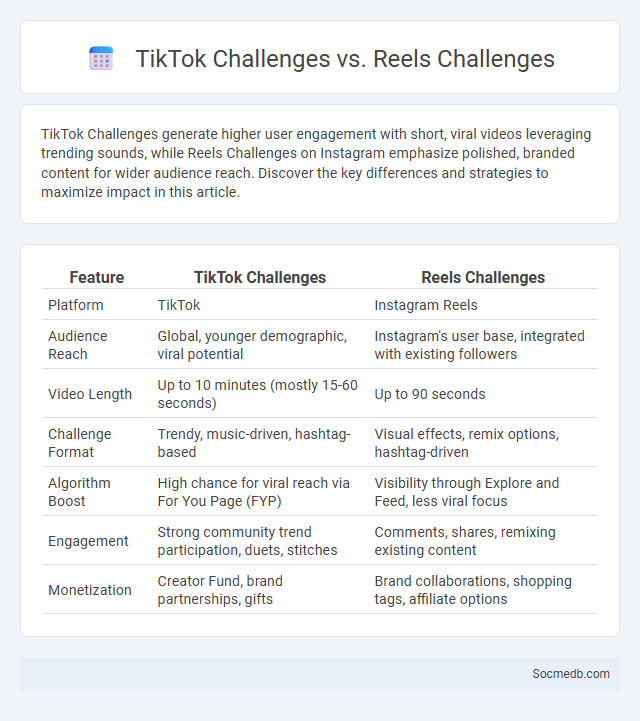
Photo illustration: TikTok Challenges vs Reels Challenges
TikTok Challenges generate higher user engagement with short, viral videos leveraging trending sounds, while Reels Challenges on Instagram emphasize polished, branded content for wider audience reach. Discover the key differences and strategies to maximize impact in this article.
Table of Comparison
| Feature | TikTok Challenges | Reels Challenges |
|---|---|---|
| Platform | TikTok | Instagram Reels |
| Audience Reach | Global, younger demographic, viral potential | Instagram's user base, integrated with existing followers |
| Video Length | Up to 10 minutes (mostly 15-60 seconds) | Up to 90 seconds |
| Challenge Format | Trendy, music-driven, hashtag-based | Visual effects, remix options, hashtag-driven |
| Algorithm Boost | High chance for viral reach via For You Page (FYP) | Visibility through Explore and Feed, less viral focus |
| Engagement | Strong community trend participation, duets, stitches | Comments, shares, remixing existing content |
| Monetization | Creator Fund, brand partnerships, gifts | Brand collaborations, shopping tags, affiliate options |
Introduction to Trending Challenges: TikTok vs Reels vs Vertical Video
Trending challenges on social media drive massive user engagement, with TikTok leading innovation through viral dance and hashtag challenges that encourage creativity and participation. Reels on Instagram leverage short, vertical video content to capture attention, blending social trends with influencer marketing, while vertical video formats dominate due to mobile-friendly consumption habits. Your brand can harness these dynamic formats to boost visibility and connect authentically with audiences across platforms.
Key Differences Between TikTok and Instagram Reels Challenges
TikTok challenges emphasize viral trends through short, user-generated videos featuring unique music and dance, leveraging TikTok's algorithm to boost rapid content discovery. Instagram Reels challenges focus on integrating with existing Instagram features like Stories and Shopping, appealing to established influencer networks and brands for monetization opportunities. TikTok's community-driven approach contrasts with Instagram's brand-centric environment, impacting user engagement and content creation styles.
The Rise of Vertical Video: Why Orientation Matters
Vertical video dominates social media platforms such as TikTok, Instagram Reels, and Snapchat, enhancing user engagement through its natural fit for smartphone screens. This orientation optimizes content consumption by maximizing visual space and making it easier for Your audience to interact without rotating their devices. Brands adapting to vertical video formats see higher click-through rates and improved retention, underscoring why orientation plays a crucial role in content strategy.
Audience Engagement: Which Platform Wins?
Audience engagement varies significantly across social media platforms, with Instagram and TikTok leading due to their visual content and interactive features like Stories, Reels, and live streams. Your brand can achieve higher interaction rates on Instagram, boasting an average engagement rate of 1.22%, compared to Facebook's 0.08%. TikTok's algorithm favors discoverability, making it the top choice for reaching younger demographics and boosting organic engagement.
Virality Factors: What Makes a Challenge Go Global
Virality factors driving social media challenges to go global include emotional engagement, easy-to-replicate content, and timely cultural relevance. Visual appeal and clear, concise instructions increase shareability and participation, amplifying Your reach exponentially. Leveraging trending hashtags and influencer endorsements further accelerates global spread by tapping into existing social networks.
Creative Tools and Editing Features Compared
Social media platforms offer a diverse range of creative tools and editing features tailored to enhance user engagement and content quality. Instagram provides intuitive filters and advanced video editing options like Reels, while TikTok excels with its extensive library of effects, soundtracks, and seamless clip trimming capabilities. Facebook integrates built-in photo touch-up tools and augmented reality effects, supporting users in crafting visually compelling posts without external software.
The Role of Music and Trends in Challenge Popularity
Music serves as a powerful catalyst in social media challenges by amplifying engagement and virality through catchy rhythms and trending songs. Trends shape user participation by creating a shared cultural experience that encourages widespread replication and creativity. Your challenges gain momentum when they align with current music hits and viral dance moves, maximizing reach across platforms like TikTok and Instagram.
Algorithm Influence: Discoverability of Challenges
Social media algorithms prioritize content based on user interaction metrics such as likes, shares, and comments, significantly impacting the discoverability of challenges. Challenges that generate high engagement quickly climb algorithmic rankings, increasing their visibility across platforms like Instagram, TikTok, and Facebook. Consequently, understanding these algorithmic patterns is crucial for creators aiming to boost participation and viral spread of social media challenges.
Monetization Opportunities on TikTok and Reels
TikTok and Instagram Reels offer diverse monetization opportunities through brand partnerships, sponsored content, and creator funds, enabling influencers to earn directly from their videos. The TikTok Creator Fund and Instagram's Bonuses program provide financial incentives based on viewership and engagement metrics. Additionally, in-app features like live gifts and shopping integrations expand revenue streams for content creators.
Future Trends: The Evolution of Vertical Video Challenges
Vertical video is reshaping social media content as platforms like TikTok and Instagram Reels dominate user engagement with short-form, mobile-friendly formats. The evolution of vertical video challenges will increasingly integrate augmented reality (AR) effects and interactive features to boost viewer participation and brand storytelling. You can expect these trends to drive more immersive and personalized experiences, transforming how audiences consume and create social content.
 socmedb.com
socmedb.com